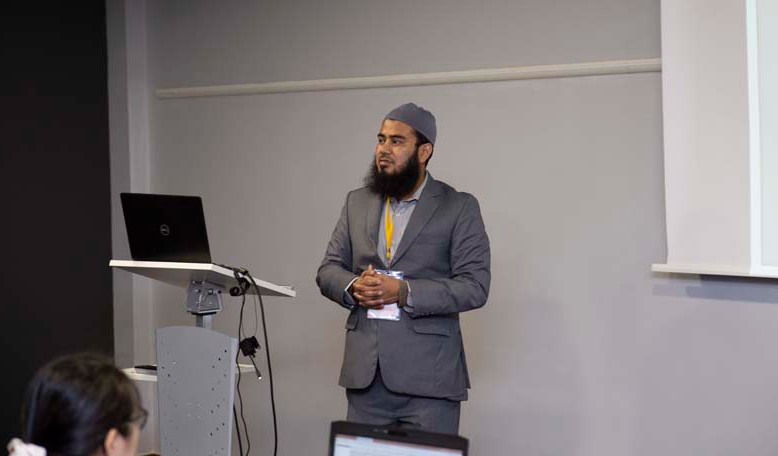Cognitive behavioral therapy through binaural beats discussed
During the EEG and Neurofeedback Research and Clinical Applications webinar held on Thursday, Pakistani Co-PI at Neurocomputation Lab, NCAI, delivered a lecture.
MSTF Media reports:
Muhammad Abul Hasan, Assistant Professor at department of Biomedical Engineering at NED University of Engineering and Technology, and Co-PI at Neurocomputation Lab at National Center of Artificial Intelligence (NCAI), gave a presentation on Cognitive Behavioral Therapy through Binaural Beats during the first webinar of the series of Innovation Lab webinars on neuroscience and electrophysiology, organized by the Mustafa
Science and Technology Foundation, ScienceBeam Institute, and Dow University of Health Sciences (DUHS).
He first introduced the term “binaural” to the audience, stating that it refers to “hearing with two ears,” adding “Binaural beats are generated sound waves that are created to influence your brain waves.”
Explaining how binaural beats work, he said they occur “when two sinusoidal waves at slightly differing frequencies are presented separately to each ear such that both sounds are mixed after perceiving into the brain.”
“It means that a tone of 400 Hz and 410 Hz presented to right and left ears respectively, produce a binaural beat sound of 10 Hz,” he continued.
Bringing up the objectives of their research project, he stated that the previous studies conducted to investigate the impact of theta, alpha, beta, and gamma binaural beats protocols on clinical symptoms, cognitive enhancement measured with behavioral changes, and electrophysiological changes measured with EEG, have some issues.
“First, they are limited to provide evidence based on brain entertainment; second, there are contradictory findings on cortical plasticity induced by BB stimulation; and third, brain connectivity was not measured for understanding mechanism of BB through lateral connections between stimulated and other regions,” he explained.
Abul Hasan then stated that the participants of this study were “36 healthy subjects with no neurological disorder, aged between 18 to 40.”
Talking about their study design, he said “the subjects were divided into 3 groups: the first group received gamma binaural beat, the second group alpha binaural beat, and beta binaural beat was received by the third group.”
EEG using 14 channels was recorded before first and after last training session for each training protocol, he said, adding that EEG was recorded in both the relaxed state and during the motor task.
“In addition to recording brain activity, Digit Span Task was used to measure cognitive scores and the reaction time to complete the level,” he continued.
Abul Hasan reported that this study found “an increase in cognitive score and a decrease in reaction time following Alpha BB, and only a reduction in reaction time with Gamma BB,” emphasizing “Beta BB stimulation did not improve cognitive score and reaction time.”
The regression analysis performed for studying trend of cognitive scores from simple to complex task (from 4 back to 7 back words), he said, demonstrate “a reduction in score from 4 back to 8 back task following BB stimulation.”
He also noted that “the neurological changes—cortical plasticity—were observed in the theta and alpha frequency bands with alpha BB stimulation only.”
Moreover, Abul Hasan and his team found out that “the imaginary coherence analysis demonstrates that BB stimulation induces change not only to the numbers and strength of connections, but also to the directions of information flow between different regions of the brain.”
The first outcome of the research they have conducted is that “the binaural beat therapies can allow better define treatment protocols for the treatment of central nervous system disorders such as pain, depression, anxiety, Autism spectrum disorder, Attention deficit hyperactivity disorder.”
Moreover, Abul Hasan announced that the results of their study can also be used “to better design cognitive studies.”
Speaking about the beneficiaries of their research, he said “in the long term, this project will have an impact on individual and on industry.”
The long-term objective of this project for health sector, he maintained, is “improving the quality of life of an individual having central nervous system disorders, i.e., promoting early neurorehabilitation.”
For research sector, on the other hand, the long-term objective of this project is that “Neuromodulation technologies would have a multidisciplinary research impact, including advanced EEG processing techniques (bioengineering), research in novel rehabilitation technologies (physiotherapy), and neurorehabilitation (neurology).”
The Innovation Lab aims to develop neuroscience and electrophysiology research in the Islamic world by holding a series of webinars, spring school, and offering grants. The second webinar revolving around Emerging Trends and Advances in Neuroscience will be held on April 8, 2021, in collaboration with Khazar University, Azerbaijan.

